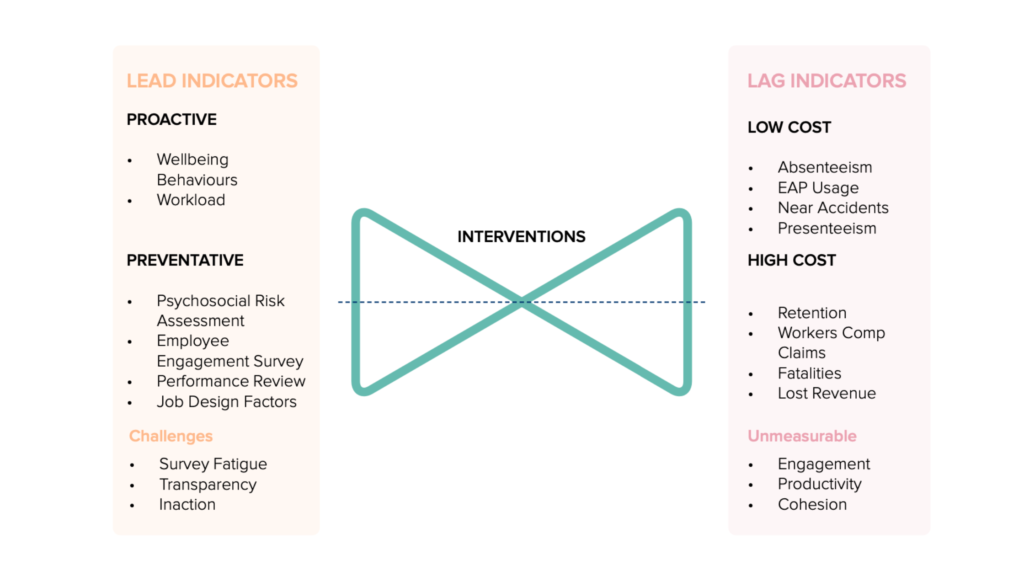Measuring employee wellbeing is critical to creating a thriving workforce, yet many organisations struggle to adopt the right metrics. The discussion around leading indicators in employee wellbeing is gaining traction as companies look to take a proactive, rather than reactive, approach. By focusing on these forward-looking metrics, organisations can anticipate challenges and address employee needs early, fostering a healthier and more engaged workplace.
What Are Lead Indicators?
Lead indicators are proactive metrics that give insights into future outcomes by measuring ongoing activities and behaviours. Unlike lag indicators, which reflect past performance (like absenteeism or turnover), lead indicators focus on factors that predict future trends. These might include employee engagement in wellbeing programs, participation in health screenings, or responses to stress management surveys.
By tracking lead indicators, organisations can identify potential issues before they escalate into larger problems. This can lead to better engagement, improved health outcomes, and ultimately a stronger return on investment (ROI) from wellbeing initiatives.

The Role of Lead Indicators in Employee Wellbeing
Employee wellbeing programs have historically focused on lagging indicators like turnover rates or healthcare claims. While these metrics provide useful data, they don’t allow for real-time interventions. Lead indicators, on the other hand, are designed to measure behaviours and processes that influence these outcomes.
For example, if participation in mental health programs is low (a lead indicator), it may signal that employees are struggling with stress but aren’t accessing the support they need. By monitoring this early, businesses can adjust programs to be more accessible or relevant, preventing higher absenteeism or burnout later down the line.
Key Lead Indicators for Wellbeing
Here are some common lead indicators that businesses can track to ensure the effectiveness of their wellbeing initiatives:
- Engagement in Wellbeing Programs: Regular monitoring of how many employees are attending health-related workshops or using wellbeing apps can provide insights into their overall engagement.
- Stress and Resilience Surveys: Frequent pulse surveys assessing stress levels, sleep quality, or work-life balance can provide early warning signs of burnout or mental health issues.
- Health Risk Assessments: Participation in biometric screenings or fitness challenges can highlight potential health risks, enabling early intervention through tailored programs.
- Employee Feedback: Tracking the feedback provided in post-training surveys or health program reviews can help organisations refine their initiatives to meet employees’ needs better.
These indicators offer real-time insights that allow HR teams to be nimble in their approach, making adjustments that prevent more severe issues from surfacing.
Why Lead Indicators Matter in an Employee Wellbeing Strategy
Lead indicators not only help in mitigating risks but also drive organisational strategy by focusing on what needs to be done now to secure future success. In the realm of wellbeing, this could mean increasing employee engagement or ensuring that mental health support is readily available.
For instance, a 2023 report by Wellics found that companies with higher engagement in wellbeing programs saw a 35% reduction in absenteeism, highlighting the value of keeping an eye on early-stage metrics. Another report showed that proactive tracking of employee participation in wellness initiatives led to a significant decrease in compensation claims and turnover.
How Lead Indicators Support Long-Term Business Success
A proactive focus on employee wellbeing through lead indicators offers clear business benefits. Companies that invest in these metrics see higher employee satisfaction, improved retention, and lower healthcare costs. In fact, studies have found that wellbeing programs that actively engage employees can generate a ROI of up to $6 for every $1 spent.
Moreover, with growing evidence that lead indicators improve organisational culture and employee loyalty, it’s clear that focusing on these proactive metrics is not just about health—it’s about long-term business success. By addressing issues early, organisations can reduce the costs associated with absenteeism, presenteeism, and turnover while fostering a more engaged workforce.

To discover more about lead and lag indicators and employee wellbeing, download our latest whitepaper.
Incorporating lead indicators into your employee wellbeing strategy can revolutionise the way your organisation approaches workforce health. By proactively addressing health risks and engagement issues, HR leaders can create a healthier, more productive work environment that drives both employee satisfaction and business performance.





